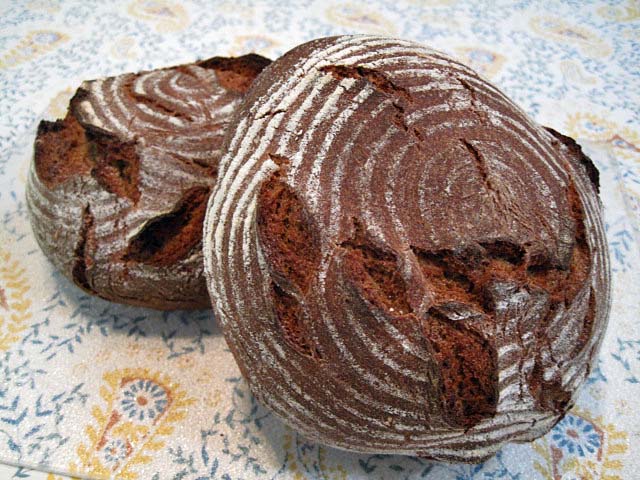
It's been quite a while since I've made a rye bread, and I've been missing it. I've been admiring the ryes other TFL members have been making, especially those with a very high percentage of rye. I've also noted the comments about the special sweet flavors reported when hot rye soakers or mashes have been included.
This weekend, I made Hamelman's “80% Rye with a Rye-flour Soaker” from “Bread.” This is the first time I've made a bread with over 70% rye flour and the first time I've used a hot rye soaker. The results were just astonishing. This is my new favorite rye bread.
I proofed the loaves seam side down, so the seam side was up when the breads baked. I did not score or dock the loaves but let them “burst” willy nilly. As occurred the last time I did this, I'd sealed the seams too well, and the loaves didn't burst as much as I'd hoped. None the less, I got really good oven spring, and the loaves had a high profile when sliced.
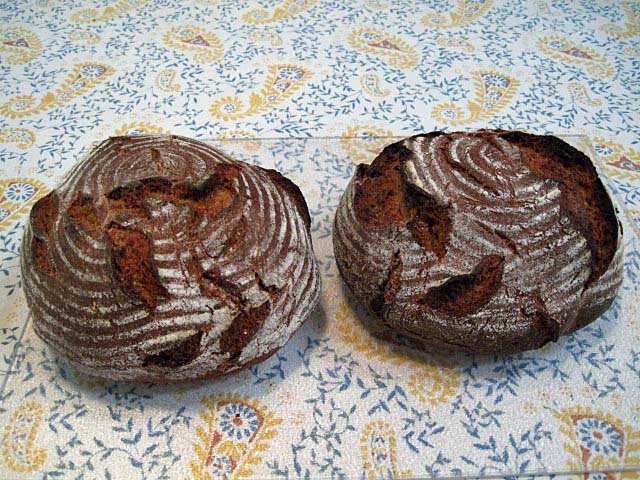
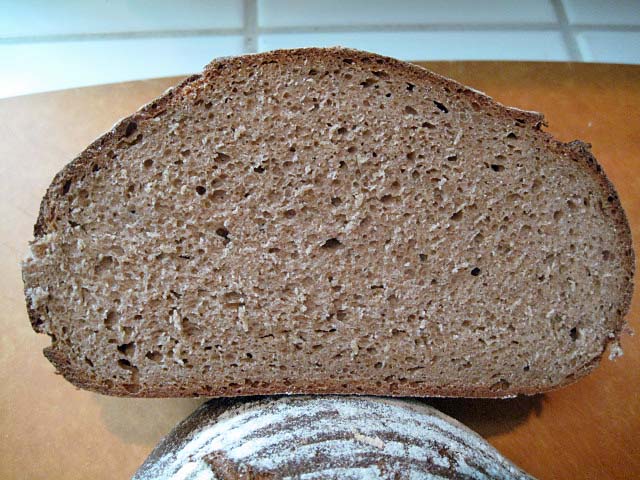
After the loaves were baked and cooled, I wrapped them in a spare raw linen couche for about 24 hours before slicing. The crust had softened and was nice and chewy. The crumb was pretty much as expected.
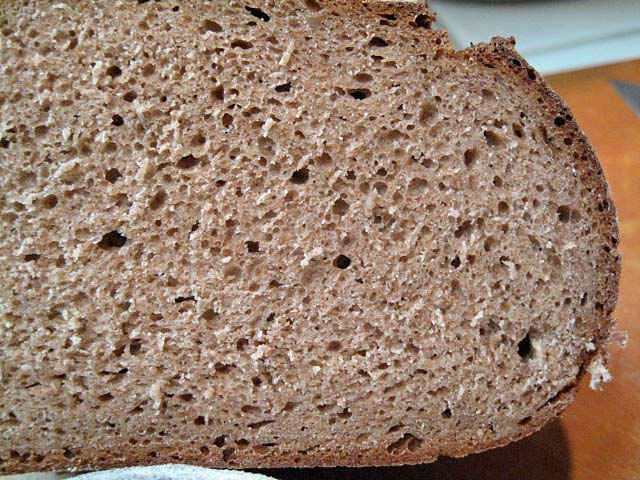
The flavor was notably sweet but with a nice tang and earthy rye flavor. It is delicious just plain and made a wonderful sandwich with smoked turkey breast. I'm anticipating great enjoyment when I have some with cream cheese and smoked salmon for breakfast tomorrow.
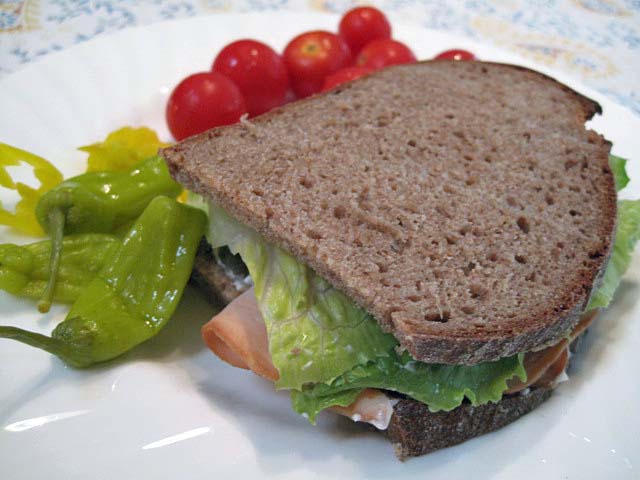
David
- dmsnyder's Blog
- Log in or register to post comments
Lovely bake and a beautiful looking crumb David. I think cream cheese and smoked salmon will never taste so good.
Larry
David
I will have to get out my book and see this one. Did you change anything from what is recorded therein?
I usually do the Heidelberg Rye from my 70's Fleishman's Yeast packets. It is a lovely bread with both cocoa and molasses and caraway. c
Hi.
I followed Hamelman's instructions exactly. I used BRM Dark Rye and KAF Sir Lancelot flours.
I recommend this one. The flavor is wonderful.
David
One of these days I hope to bake off a loaf of rye that actually rises in the oven - I seem to be specializing in rye rocks.
Thanks, Franchiello. It is good.
For rye bread to have good oven spring, you need an active starter (rye sour) and/or added yeast. Then, steaming the oven is really important to allow the loaf to spring before the crust starts to form. Most of the things I've read say you have a shorter period of steaming with ryes than with wheaten loaves, but having steam for at least the first 5 minutes is essential.
Hope this helps.
David
you may plan on trying in the near future. Both in color and taste.
Beautiful rise on these, David. Perfect crumb and good looks! :)
I've used cold salty soakers that included rye but also other grains and seeds. I know that's not a good basis for comparison.
You have a lot more experience than I with rye soakers. What do you think the difference would be between a cold soaker, boiling water soaker and a cooked rye mash?
I do want to try other variations, but this one is so good I may get stuck on it for a while.
David
My goodness, you've done a lot of baking this weekend! All look great, as usual.
Enjoyed your post on the pot-bakes. Might have to get the old Lodge Dutch oven back on the bread line.
Your rye is lovely.
And I didn't post on the SJ SD baguettes I baked today.
David
David, that looks beautiful and yummy. The color is incredible.
I haven't baked rye because no one else in the house likes it much. Maybe I'll get to try some of this in Fresno, if you want to bake me a batch.
Glenn
Not only is this rye yummy with smoked meats, it was delicious with krupnik for dinner tonight. I'll finish a half-loaf for breakfast tomorrow with lox, but there's a loaf and a half in the freezer. If it doesn't last until Thanksgiving, we'll bake some more.
If your exposure to rye has been limited to light caraway rye, this is a different food. It may be an acquired taste, but it must be tasted to be believed.
Rye baking is very different from baking wheat breads. The dough is entirely different - sticky and clay-like - and the fermentations and proofing are very short. The key is that most of the rye is pre-fermented and/or in a soaker.
Maybe we should make some to give you the experience and to ship to (our middle brother) Aaron. I know he'd love it!
David
Glenn
Great! David... Lovely Rye...! Yum..
Bold, loud and tasty! Meant all in a good way of course.
Much better height than my attempts with this same loaf!
David
That's a great crumb David.
The oven spring from steaming and correct proof is excellent.
I've made this loaf too; flavour is outstanding, as you say. I made it in a loaf pan! http://www.thefreshloaf.com/node/17539/slight-variations-two-more-formulae-hamelman039s-quotbreadquot
All good wishes
Andy
I actually thought about pan-baking this bread. One of these days I'm going to spring for a pullman pan. Probably when I decide I'm ready to try 100% rye. It might be sooner than later.
David
David, judging from the crust your bread looks like a chocolate cake. The crumb looks perfect, too. Really beutiful.
I am super impressed with the oven spring, since over-proofing has been my big hurtle to overcome when it comes baking high percentage rye.
Looks like I'll have to pony up for Hamelman's book one of these days. I haven't tried any of the soaker methods (cold/salty, boiling, or mash) yet, so don't have first-hand understanding of how they affect flavor.
Wonderfully rich color and a well-aerated crumb, too. Good baking!
Paul
David
Hi David
What more can one say that hasn't already been said, it looks superb in every way and the sandwhich shot had me salivating to the point that i will now have to stop and have breakfast, but knowing there is not really anything in the pantry that will compare. Well done David
Regards Yozza
Hi David,
That is really beautiful bread! I have made it once before, but my results were much less spectacular than yours. Not surprisingly, since I have just started exploring high percentage ryes. I am planning on trying this loaf again. I was wondering if you would not mind clarifying the soaker procedure for me. The directions require boiling water to be poured over the flour, and then covered immediately. When I did that, there was a lot of dry flour, so I re-opened the container and stirred, all the while being nervous about all the steam escaping. What is the correct way to prepare this hot soaker?
Thank you!
Kroha
I did exactly as you did and got exactly the same result.
It's possible that Hamelman developed the formula with less absorbent rye flour, but it may just need both a bit more water and a stir.
Or maybe the formula has an error. Hmmm ... Maybe should compare the home formula with the larger versions.
David
So, I made this bread today, again, my results are not as spectacular as yours -- much less oven spring, and the loaves spread sideways more than upward. I baked in a gas oven, which is good at maintaining temperature but is very hard to steam because it vents. I will try again in an electric oven soon, and will check the soaker in the formula for errors.
kroha
Hi, Alexandra.
This bread formula is from Jeffrey Hamelman's "Bread." This is a wonderful book that I recommend highly. It has a lengthy chapter on rye breads with a great deal of fundamental information about rye sours, the special requirements for baking high percentage ryes, etc.
I suggest you buy the book or get it through your local library.
Andy (ananda) has posted the recipe with a slight modification that he described. He does not describe the method in detail however. Here's a link: Slight Variations on Two More Formulae from Hamelman's "Bread"
David